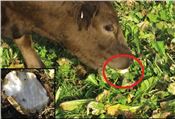Bulb Yield And Quality Of Forage Turnips

KENNY SIMON, DIRK PHILIPP, JOHN JENNINGS, ROBERT RHEIN AND SHANE GADBERRY
FAYETTEVILLE, ARK.
Brassicas are an attractive choice off all and early winter grazing for livestock. Brassicas are fast-growing, high in nutritive value and thus complement the existing forage base by closing gaps in forage production. Based on observations from on-farm demonstrations, forage turnip managed for stockpiling produced a substantial amount of bulbs in addition to the leaf yield. With proper grazing management, livestock graze the bulbs, therefore adding grazing days. However, limited information is available for bulb dry matter production and quality in the southeastern U.S. A replicated research trial was conducted at the University of Arkansas Watershed Research and Education Center (WREC) in Fayetteville to compare total bulb dry matter production and quality of two forage turnip cultivars. The two forage turnips compared in the trial were Appin and Barkant. Appin is a product of Ampac Seed Company. Barkant is a product of Barenbrug Seed Company. Brassicas were no-till planted on a well-firmed, disked seedbed on August26, 2013. Prior to planting on August 26, 2013, forage growth at the experiment site was suppressed with glyphosate, and the area was disked twice then culti-packed. The seeding rates were 5 lb/acre. Preformulated NPK fertilizer and boron were applied to each plot using soil test reports and recommendations for brassica production. The forage turnips were harvested after 4 months (December 3) of growth. The forage turnips produced a high proportion of bulb yield in addition to leaf yield. Bulb production was limited until the plants reached 16 to 18 inches. However, as the plant continued growing, a significant amount of bulb yield was produced (Figure 1). Both varieties produced similar bulb DM lb/acre Appin (2,882) and Barkant (2,884). Bulb yield was 47 percent and 42 percent of the total yield for Appin and Barkant, respectively. Appin produced a small, round bulb (<5”) firmly anchored in the soil. Barkant produced a moderate, oval shaped bulb (4-8”), with 50 percent of the bulb above the soil surface. Percent CP and TDN were similar for Appin (10.9 and 78.3) and Barkant (10.0 and 80) (Figure 2). With their high digestibility and low fiber content, turnip bulbs could actually be considered as “concentrates” rather than “forage” in nutritional planning for livestock. Forage turnip bulbs have the potential for providing a high-yielding and high-quality cost-effective source of energy to livestock in late fall or early winter. Yields indicate they could be a good source of grazing even after a hard freeze (25° F) inhibits plant growth.
Figure 1: Total bulb and leaf dry matter production after 4 months of growth.
Appin Barkant
Bulb yield 2,882 2,884
Leaf yield 3, 266 3,974
Figure 2: Bulb quality of forage turnip. Values expressed on a DM basis
Appin Barkant
CP 10.9 10.0
ADF 24.2 18.3
NDF 25.0 20.4
TDN 78.3 80.0
KENNY SIMON: Program Associate, University of Arkansas
DR. DIRK PHILIPP: Assistant Professor, University of Arkansas
DR. JOHN JENNINGS: Professor, University of Arkansas
ROBERT RHEIN: Farm Foreman, University of Arkansas
DR. SHANE GADBERRY: Associate Professor, University of Arkansas